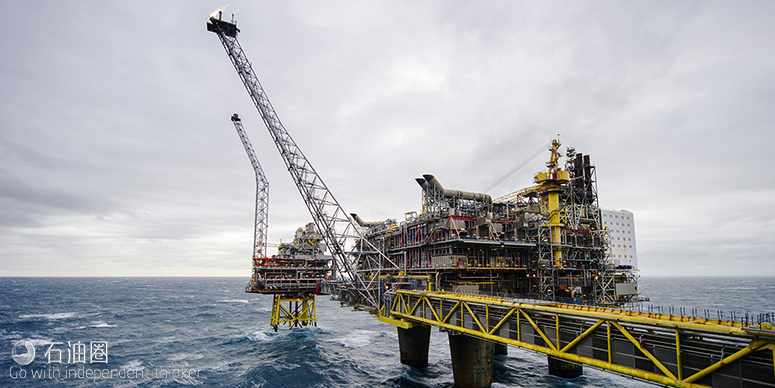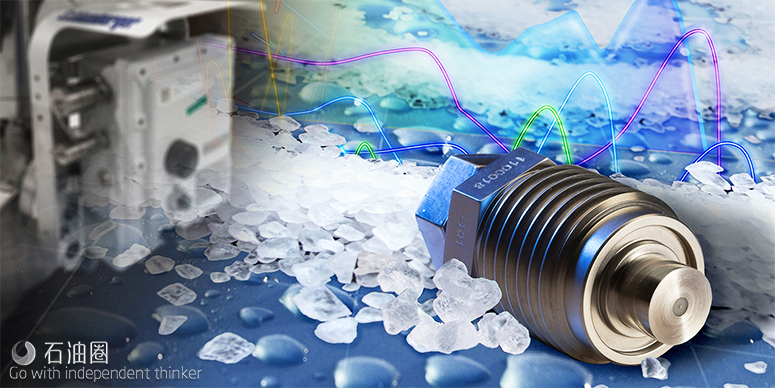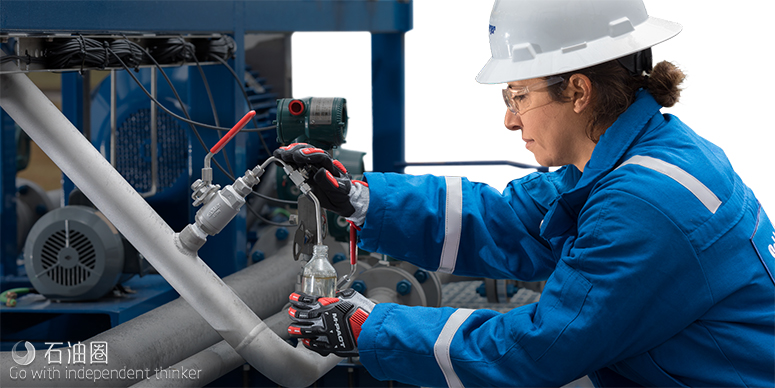Convention and the challenge offshore
National Oilwell Varco (NOV) handles produced water issues both onshore and offshore with an array of technologies designed to deliver smart, cost-effective results to clientele across the globe. In some cases, that means taking a closer look at what has become the norm across the industry and turning it on its ear—in the case of NOV’s horizontal gun barrel (HGB) separators, quite literally. The company examined the traditional vertical separators being used for decades and found them inefficient, with solids buildup leading to poor oil/water separation. In late 2015, the company installed its first HGB, designed to give the user a significant increase in recovered oil volume, thus adding profitability. Combined with NOV’s online Tore de-sanding technology, the vessel provides greater efficiencies and reduced maintenance costs.
Well fluids are introduced into the HGB, where two distribution baffles spread the fluid across the vessel into the primary separation section. Oil and water separate via gravity, and solids settle and accumulate on the bottom of the separator. The vessel can operate at a range of pressures, allowing the effective flow of the separated streams to lower pressure receiving systems by level control instrumentation.
“We are seeing success with our horizontal gun barrel separators, which are a more modern take on a traditional and far less efficient tank-based design,” explained James Vanjo-Carnell, Produced Water product line manager for NOV Completion & Production Solutions. “The horizontal gun barrel was introduced to the North America onshore market in response to large flowback produced water volumes in unconventionals. The HGB improves oil recovery and solves solids buildup issues while maintaining cost competitiveness for saltwater disposal [SWD] facilities. To date, over 70 HGB systems have been installed in North America.”
NOV’s WaterWolf is another tool used to recover oil and suspended solids from produced water in a single stage of treatment, without chemicals or filters. Introduced in 2015, WaterWolf uses enhanced gravity systems to separate oil, eliminating or reducing the need for treatment chemicals altogether. It builds on the heritage of proven hydrocyclone technology, long used in offshore oil fields to optimize produced water handling and extend well life. The dynamic oil recovery (DOR) processes are unaffected by changes in upstream flow rate or pressure and can be adapted to a wide variety of treatment scenarios.
“We’ve fed back into the design to continuously improve the offering,” Vanjo-Carnell said. “The technology always offered a balance that allowed a type of ‘fit-and-forget’ system within the DOR concept that eliminated turndown and shear issues associated with de-oiling and de-sanding hydrocyclone operation. The concept builds on the use of no-shear pumping systems that NOV manufactures within an automatically balanced flow loop. Technologies can be incorporated into the DOR loop to enhance robustness and processing capability if required. We’ve now enhanced this with a system that better manages reject fouling issues, which can be further optimized by digitization techniques.”
NOV’s water management technology offerings continue to grow. “We have a much more expansive produced water treatment portfolio since WaterWolf’s inception through our acquisition of Fjords Processing,” Vanjo-Carnell said. “Many of the technologies that came with it are ideally suited to become part of the WaterWolf DOR concept, such as our Mare’s Tail inline oil droplet coalescer and our compact flotation technologies. We are also working to increase the capacities of the WaterWolf system and are currently designing a mobile, skid-mounted, produced water treatment system based on Water-Wolf concepts that will achieve 126,000 barrels per day in a transportable footprint of 12 by 40 feet.”
Like its peers, NOV is keen to evolve with the changing demands of its client base. As new concepts and technologies are introduced, new rules are implemented and field demands morph over time, the company strives to keep ahead of the game when it comes to improved economics and overall cost-competitiveness.
“We’ve just come out of a really tough period within the industry, and we have simply had to sharpen our pencils,” Vanjo-Carnell said. “We see the same demand for aggressive cost performance but also an awareness pertaining to system process and mechanical performance. This is an interesting challenge for us, as it is in line with our core principles. We aim to use smart engineering to offer technically and commercially aggressive solutions—backed up by our validation techniques and experience base—to give the industry what it needs.”
Customer needs are varied, especially when considering produced water treatment requirements for offshore operators. The evolution of discharge regulations in certain parts of the world, such as Mexico and Brazil, are starting to highlight the increasing importance of understanding dissolved organic loading as this applies to typical offshore produced water treatment design.
“A dissolved treatment kit is expensive, and when you are working with large produced water flows, it becomes prohibitively so,” Vanjo-Carnell said. “To be able to offer an economical and technically acceptable design, it is important to understand the target dissolved organics and be able to map their fate through pressure and temperature changes that occur within a traditional (mechanical) produced water treatment system. Once this has been completed, the true loading and removal demand from a dissolved treatment system can be defined, and the dissolved system becomes more economically viable.”
Within the offshore sphere, NOV is seeing a push toward reduced/unmanned facilities. Unmanned facilities can make lower yield or aging fields more competitive to produce since the labor (and all associated logistics) costs are reduced.
“This means that to be able to reliably meet regulations for discharge, where produced water re injection isn’t available 100%, the produced water treatment equipment has to be reliable, predictable and very simple to maintain since the maintenance window is likely to be quite small,” he said.
A spin on the road to delivery
For operators, formulating the right water management scheme is dependent on a number of factors including land position—continuous acreage allows for centralized processing facilities with an integrated water pipeline network whereas disconnected acreage requires trucking of the water. To offset rising transportation costs, operators and service providers are looking for more robust mobile solutions featuring a reduced footprint and lower-weight equipment. Automation of basic activities, including inline sampling, also remains a priority for both service companies and operators as a means of improving process safety and managing labor expenditures, according to Schlumberger. This requires advancements in sensor technologies for conducting various water composition studies—from the on-the-fly water quality analysis to determining salinity levels.
“For the latter, Schlumberger has launched the AquaWatcher Surface water salinity sensor that determines water salinity in real time by employing microwave sensor technology to continuously measure water conductivity in wet gas and multiphase (water-continuous) flow,” said Laure Mandrou, marketing and technology manager for Testing Services at Schlumberger. “This automated measurement reduces operating costs by eliminating manual water sampling and analysis.”
In the Midland Basin, the AquaWatcher Surface sensor was installed at a well site for a long-term flowback test, and it reported continuous measurement of the water conductivity to the data acquisition computer. The real-time salinity was used to automatically update monitoring of the flowback water properties. Personnel was not required to visit the remote well site and manually measure and enter the salinity value. The accuracy of the flow-rate measurements was improved for better understanding of the results of the flowback test while operating costs for site visits were significantly reduced.
“What these current trends have in common is a pursuit of optimizing water treatment operations while decreasing environmental impact,” explained Katherine Rojas, water business manager at Schlumberger. “Ultimately, reducing the cost per barrel of water through a combination of innovative and environmentally minded solutions and engineering processes will continue to be a driving force for all major water management decisions.”
Schlumberger’s footprint in the water management space continues to expand with the recently introduced Voraxial impeller-induced cyclonics. Debuted in North America, the new technology provides instantaneous, continuous, concurrent separation of water, oil and solids at very high flow rates to bring new efficiencies to oilfield water sourcing and management.
“This efficient inline water treatment process cleans water from varying sources by separating out oil with any entrained gas and solids with different specific gravities,” Rojas said. “The technology outperforms conventional centrifuge or hydrocyclone separation, which requires a booster pump to counter its performance-constraining pressure drop and must use multiple units and multiple passes for the separate removal of oil and solids from the liquid.”
Instead of employing a conventional hydrocyclone to convert the incoming liquid velocity into rotary motion for separating heavy and light components, Voraxial cyclonics use a unique no-shear impeller to induce radial and axial flow for three-way separation of water, oil and solids. The application of simultaneous separation during continuous flow means that only one pass is required through the unit, and there is no associated pressure drop.
Reliable delivery of a high-rate daily output of frac-grade water, once only a remote technological vision, is now a reality. Schlumberger’s oilfield water treatment services enable using surface water for onsite frac water sourcing. By substantially reducing the need to access and produce from freshwater aquifers or truck-in water supplies, the company’s self-contained, trailer-based, plug-and-play system significantly reduces water costs. The mobile in-line treatment automatically adapts to changing input quality and quantity without interrupting operations for reconfiguration. Produced water also can be easily treated to augment frac water inflow.
“The performance predictability of single-sourced or commingled frac water is assured by at-rate separation as needed,” Rojas said. “Nonproductive time resulting from poor or inconsistent water quality, such as screenouts and pump failures, is prevented to support operational continuity. Based on customers’ water requirements, the Voraxial impeller-induced cyclonics inside the mobile unit can be paired with a high-intensity UV [ultraviolet] light source to efficiently neutralize any biologically active agents in the water and prevent souring. Further chemical treatments can be added on the fly in the mobile unit.”
Depending on specific water needs, the separation process can be followed with UV light, oxidation and biocide treatments to destroy polymer content for frac water recycling, sterilize microbes for pit and pond maintenance, and reduce select ions for protection of tanks and pipelines and SWD.
Schlumberger is continuing its work with clients to achieve business, environmental, social and governance objectives when it comes to water management. Given the radically different variables that can be applied to any one project, the company recognizes that there is no magic solution applicable to all scenarios. It continues to come down to having the right tools and expertise.
“Streamlining water treatment through innovative technologies and environmentally intelligent chemistry applications is an important step in both improving performance and reliability and adding new dimensions to the professional competency of personnel,” Rojas said. “This can be accomplished when operators and service companies collaborate on sharing data from performance testing, including full analytical profiles of chemical constituents and process simulation testing, to develop comprehensive water management practices.”
As the water treatment sector matures and expertise becomes more attainable and transferable to field personnel and remote operation centers, workflows for mechanical separation and chemical treatment processes will become more defined, enabling operators to achieve consistency in treated water quality, according to Schlumberger.
“As a result,” Rojas added, “these improvements will lead to smaller equipment footprints, less chemicals, less people on the ground and less waste—all contributing to a sustainable use of environmental and human resources.”

 石油圈
石油圈


